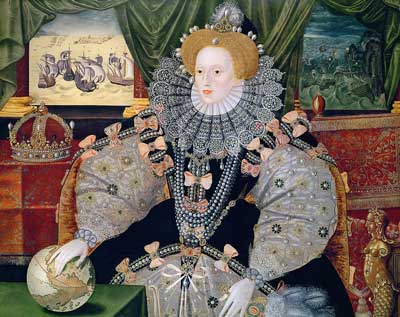Elizabeth – the virgin queen (?)
Elizabeth (recreated in Sister to Sister as Eliza Rose) was famous for her virginity, while her father, Henry VIII … wasn’t. Nevertheless, she was a chip off the old block. Like Henry, Elizabeth morphed from a beautiful, charismatic monarch into something of a caricature of herself. Henry: the massive shoulders, the power stance, that terrifying stare. Elizabeth: the chalky white face, the tortured red curls, the neck ruffs the size of an occasional table.
Above: Princess Elizabeth, c1546, aged 13 or 14. Painting attributed to William Scrots (Royal Collection).
But Elizabeth wasn’t all Tudor. She had her mother Anne Boleyn’s dark brown eyes, sharp wit and feistiness.
Henry slid into tyranny, but Elizabeth held strong to her middle way. Her father was a wifeaholic, but Elizabeth was determined not to marry: ‘I had rather be a beggar and single than a queen and married,’ she famously said.
Elizabeth’s coronation portrait, painted c1600 (unknown artist).
The Virgin Queen – was she? The love of her life was Lord Robert Dudley. They danced, they rode, they flirted, he had rooms adjoining hers. Virgin? Really? Well, maybe … wouldn’t her women have known, had she not been? But she was queen. She could threaten them with – I don’t know, death? – if they betrayed her trust.
Elizabeth’s achievements were all the more remarkable given the prevailing attitudes towards women. After the religious upheavals of Henry VIII’s and Mary Tudor’s reigns, Elizabeth firmly steered England through a middle way, allowing people to worship as they chose. It was a time of peace, and when Philip of Spain made his move, she inspired her armies to defeat the greatest naval power of the time – the Spanish Armada. Nice try, Phil.
The famous ‘Armada portrait’ painted against a backdrop of the Spanish Armada, which was defeated in 1588
The Elizabethan era was a golden age of discovery and the arts. Shakespeare and Marlowe were writing plays and poetry the like of which haven’t been seen since. Francis Drake and Walter Raleigh were undertaking epic voyages of exploration – they were the super-celebs of the day. While the Spanish were hoarding gold from the New World, Sir Walter was bringing back potatoes – and which, honestly, is more important in our lives?
The Elizabethan era was a golden age of discovery and the arts. Shakespeare and Marlowe were writing plays and poetry the like of which haven’t been seen since. Francis Drake and Walter Raleigh were undertaking epic voyages of exploration – they were the super-celebs of the day. While the Spanish were hoarding gold from the New World, Sir Walter was bringing back potatoes – and which, honestly, is more important in our lives?




